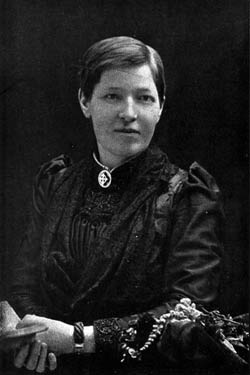Readings:
This is a 2018 addition to A Great Cloud of Witnesses.
Return to Lectionary Home Page
Webmaster: Charles Wohlers
Last updated: 10 Nov. 2018
MARY SLESSOR
MISSIONARY (JAN. 13, 1915)
 Mary Mitchell Slessor (2 December 1848 – 13 January 1915) was a British Presbyterian missionary to Nigeria. Once in Nigeria, Because of her understanding of the native language and her bold personality Slessor gained the trust and acceptance of the locals and was able to spread Christianity while promoting women's rights and protecting native children. She is most famous for having stopped the common practice of infanticide of twins among the Ibibio people, an ethnic group in southeastern Nigeria.
Mary Mitchell Slessor (2 December 1848 – 13 January 1915) was a British Presbyterian missionary to Nigeria. Once in Nigeria, Because of her understanding of the native language and her bold personality Slessor gained the trust and acceptance of the locals and was able to spread Christianity while promoting women's rights and protecting native children. She is most famous for having stopped the common practice of infanticide of twins among the Ibibio people, an ethnic group in southeastern Nigeria.
Mary Slessor was born on 2 December 1848 in Gilcomston, Aberdeen, U.K. to a poor working-class family. Her mother was a devout Presbyterian who read each issue of the Missionary Record. Slessor developed an interest in religion and when she heard that David Livingstone, the famous missionary and explorer, had died and decided she wanted to follow in his footsteps.
Eventually, she applied to the United Presbyterian Church's Foreign Mission Board. Slessor, 28 years of age, red haired with bright blue eyes, was first assigned to the Calabar region in the land of the Efik people.In August 1888, Slessor traveled north to Okoyong, an area where male missionaries had been killed. She thought that her teachings, and the fact that she was a woman, would be less threatening to unreached tribes. For 15 years, Slessor lived with the Okoyong and the Efik people. She learned to speak Efik, the native language, and made close personal friendships wherever she went, becoming known for her pragmatism and humour. Slessor lived a simple life in a traditional house with Efiks. Her insistence on lone stations often led her into conflict with the authorities and gained her a reputation for eccentricity. However, her exploits were heralded in Britain and she became known as the "white queen of Okoyong". Slessor continued her focus on evangelism, settling disputes, encouraging trade, establishing social changes and introducing Western education.
It was the belief in Calabar that if a women had twins one of them had to be a devil so the twins were left in the jungle in clay pots to die. Mary Slessor successfully fought against this practice of infanticide of twins at infancy, often by adoping them.
In 1892, Slessor became vice-consul in Okoyong, presiding over the native court. In 1905 she was named vice-president of Ikot Obong native court. Slessor's health began to suffer in her later years but she remained in Calabar, where she died in 1915.
more at Wikipedia